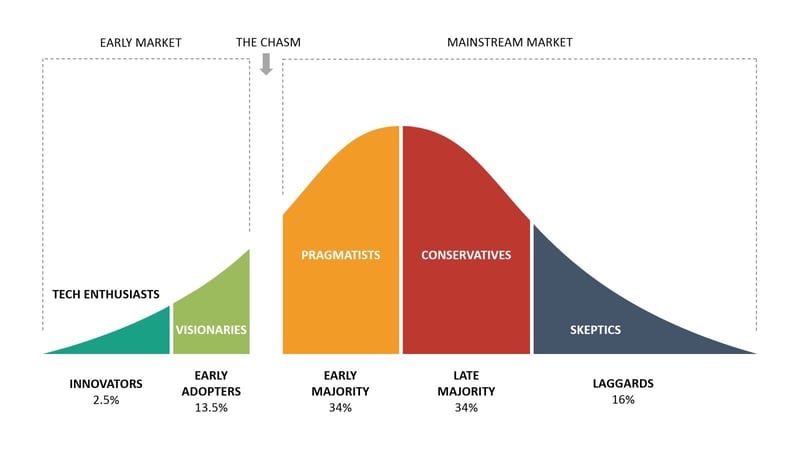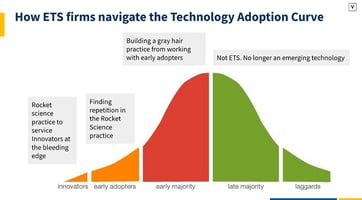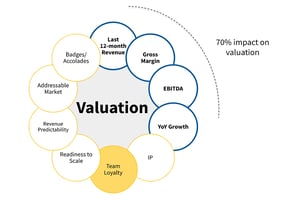This article is about the importance of serving the US market and establishing a presence there. If...
Emerging Tech Products And Services: A Match Made In Heaven
In our article about the role of an Emerging Tech Services company throughout the product lifecycle, we talk about how ETS businesses are able to achieve massive scale by riding the wave created by the disruption from the product companies. But today we want to focus on another aspect of the relationship that Geoffrey Moore talks about in his book, “Inside The Tornado”.
Emerging Tech is a Blue Ocean
The emerging technology market is characterized by the creation of an entirely new market space driven by a new technology. There are few competitors, if any. Customers look to the ETS business for more than just staffing. They rely on the firm’s deep technical expertise to solve an unknown problem. Margins tend to be higher and the requirements more customized, leading to pricing primarily set by the value you deliver - not what the other guy charges. All this means, that, as Chan Kim and Renée Mauborgne put it, an emerging technology is a blue ocean.
Tech Adoption is a Wave
As Geoffrey Moore describes in his book “Crossing the Chasm”, the way a new technology rolls out into the market looks a lot like a curve - a wave, if you will. This wave is typically divided into five stages that demarcate how different types of users respond to and adopt the technology in a sequence.

At the start of the wave, there are the Innovators. These compromise a small but vital market segment since these are the risk-takers and technology enthusiasts willing to chart unknown waters. They have a higher tolerance for failure than any other market segment, and they’re willing to bet on not just new technologies but new teams that can work with it. Geoffrey Moore calls these the deep waters of the tech adoption curve, and they’re the perfect environment for emerging tech services businesses to start in.
This stage is closely followed by the Early Adopters, who are not quite as adventurous as the Innovators but are still more open to change than most excited to support new technologies. Together with the Innovators, they often comprise the earliest customer base of any ETS. Working with them helps refine your technology practice and helps uncover potential for repeatable, modular tasks and services within your overall offering.
The crest of the technology adoption wave is the Early Majority. These are the core customers of an emerging technology product business. They’ve seen what the new technology can do, they can envision its benefits for their organization, and they’re willing to invest in provided they’re reassured of both the need and the delivery capability. They want to see your case studies, your certifications, and your track record. And they’re willing to pay a premium for your experienced expertise.
The technology adoption wave continues after this, but an ETS business doesn’t - in the sense that after this, the technology it services would no longer be emerging. By the time a technology sees widespread adoption by the late majority, it is, by definition, no longer an emerging technology.
The Partnership At The Crescendo
ETS businesses don’t just ride the current of an emerging technology’s success. They actively build the broader technological ecosystem that enables this success. In the early stage, the product is rough, and it doesn’t handle many customer use cases. The know-how to use the product is not well-known. Integrations with other systems have not become standard features and are commonplace.
As such, the market for customers able to independently deploy the solution is very small. The early market is very small to begin with because it requires the customers to be ready to take the risk on an unproven technology.
To succeed, a product company needs to build a cadre of ETS partners that will integrate their products into their customer’s workflows. With the help of these service partners, the product no longer puts the onus of both implementation skills and risk acceptance on the customer but can rely on the service partner to provide an expert-caliber implementation that showcases the power of the product.
The success of these early implementations is crucial to the overall success of the emerging tech platform. Without the ETS provider, the product would not be able to win enough of the early market to enter the mainstream.
The Maturing Of The Market
As the market matures, the role of the ETS moves from custom solution development to taking advantage of standardization with some customization. This allows the ETS to offer a robust solution for larger, more complex deployments. The early majority is a group that wants to play it safe. Expectations change to an implementation that is complete and reliable. Room for experimentation shrinks, as does the need for greater customization on top of what you've already built.
Beyond The Early Majority
The truth is the service provided will start to get commoditized as the technology becomes ubiquitous and well-understood. The nice margins that the service company makes will begin to disappear.
Companies operating in an emerging tech sector and those operating in a commoditized sector have to operate under very different constraints. They have fundamentally different value disciplines. And since the change is accompanied by shrinking margins, it is an extremely painful transition to make.
Realistically, the ETS company cannot survive this change. Instead, we recommend one of the following two options:
-
Exit the company to a GSI that is at risk of losing customers without adding this emerging technology capability.
-
Create a constant pipeline of new and innovative work, always allowing the company to operate as a premier provider of services on new, emerging technologies.
In both cases, the best time to put either option in motion is when the business commands high margins to maximize the outcome.
Wrapping Up
Unlike other kinds of service businesses, ETS businesses actively shape the technology they deliver. This unique role is another example of how they straddle the divide between product and service, acting as something a bit like both yet entirely new. Service businesses tend to get a bad rap for using and not creating technology. They're seen as passive consumers.
However, emerging tech service businesses occupy a liminal space that gives them the power to innovate within emerging technology, test and extend the limits of its applicability, and in doing so, shape its further development and adoption. They amplify the success they thrive on.
Without emerging technology services companies, emerging technology product businesses would see slower adoption, higher failure rates due to botched implementations, and missed business opportunities.
Their partnership with ETS businesses leads to a synergy that enables each to achieve far more than would be possible otherwise. This synergistic model powers Vixul's belief in and efforts for an ecosystem for emerging technology services, both for the good of the ETS businesses and for tech entrepreneurship as a whole.
If you’re an emerging technology services company ready to accelerate your growth, apply to be part of Vixul. Applications for the a25-1 cohort are open now!




